This post may contain affiliate links. Please read my disclosure.
Savor every bite of this mouth watering Sous Vide French Dip! It’s made with melt-in-your-mouth sous vide beef, sautéed onions and melty cheese all piled on a French roll with horseradish sauce and pan juices for dipping! It’s messy, delicious and the most comforting meal!
If you’ve never enjoyed a beef dip sandwich before, you are seriously missing out! I don’t know what I love more - the tender beef or the flavorful jus for dipping!
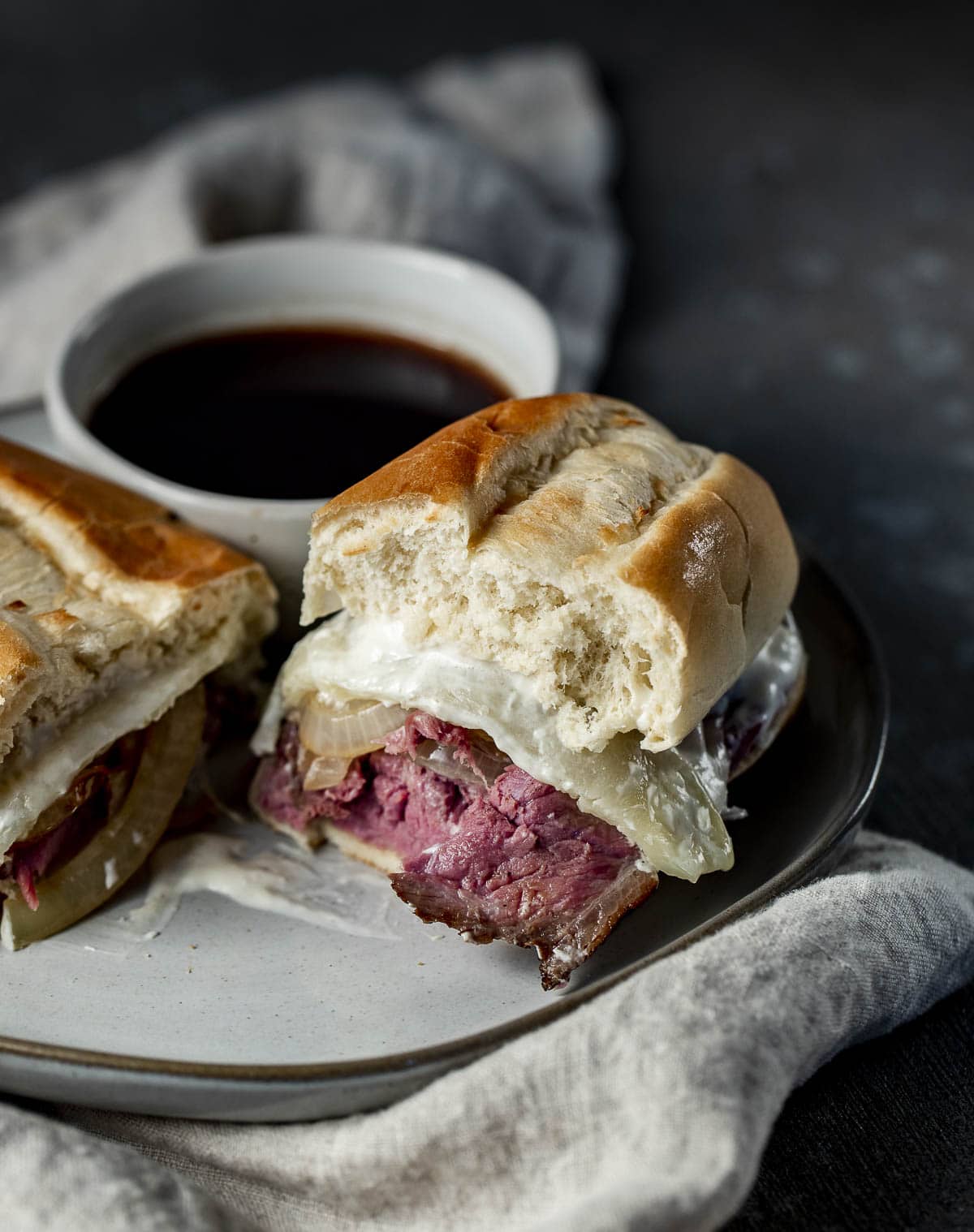
These have been on repeat in our house lately! We’ve been pairing them with these duck fat parmesan truffle fries, but you can also serve them with these baked parsnip fries or these ultra crispy air fryer french fries.
I mean, who doesn’t love the comfort of a hot beef sandwich and fries (like this sous vide pastrami or sous vide hamburger)?! Especially slathered with our favorite horseradish sauce (you could totally use remoulade also).
Jump to:
What is a French dip?
A French dip is a hot sandwich made with thinly sliced beef, melted cheese and sautéed onions, placed on a French roll or baguette and served with pan juice for dipping. It’s also called a French dip sandwich or a beef dip.
Want to Save This Recipe?
Enter your email & I'll send it to your inbox. Plus, get great new recipes from me every week!
By submitting this form, you consent to receive emails from Went Here 8 This.
Why this recipe works
- The key to a good French dip is tender beef and flavorful jus, and the sous vide cooks both to perfection! The beef and jus cook together in a vacuum sealed bag for 24 hours. All of the juices are locked in for maximum flavor and tenderness.
- Since the sous vide cooks beef low and slow, it’s great for leaner cuts of beef that are not usually tender, like the round roast we’re using in this recipe, this sous vide rib roast or this sous vide chuck roast.
- It’s almost impossible to overcook beef in the sous vide. The controlled water bath brings the beef to your preferred temperature and keeps it there, so it doesn’t dry out or get mushy.
What is Sous Vide?
Sous vide is basically a method of cooking using what is called an immersion circulator (i.e. the sous vide machine). This immersion circulator circulates water in a temperature controlled water bath at a certain temperature to perfectly cook your food every time.
Because the temperature doesn't change, and it keeps your meat (or dessert, veggies, etc.) at the same temperature, your risk of overcooking becomes very minimal.
To learn even more about sous vide cooking, head over and read "what is sous vide cooking and the benefits of sous vide cooking."
What is the Water Displacement Method?
The displacement method is where you slowly submerge a ziplock bag in water pushing the air out of the top of the bag (the bag should be slightly open at the top to allow air to escape).
Use a clip (I use sous vide magnets) to clip the bag to the side to keep it from floating and getting air and/or water inside.
Tools Used
You will also want to check out these posts on the best sous vide containers and the best sous vide bags for more information!
Other sous vide beef recipes
We have been doing ALL the sous vide cooking lately. And have just been having an awesome time - the sous vide makes meat SO GOOD. Here are some of our favorites:
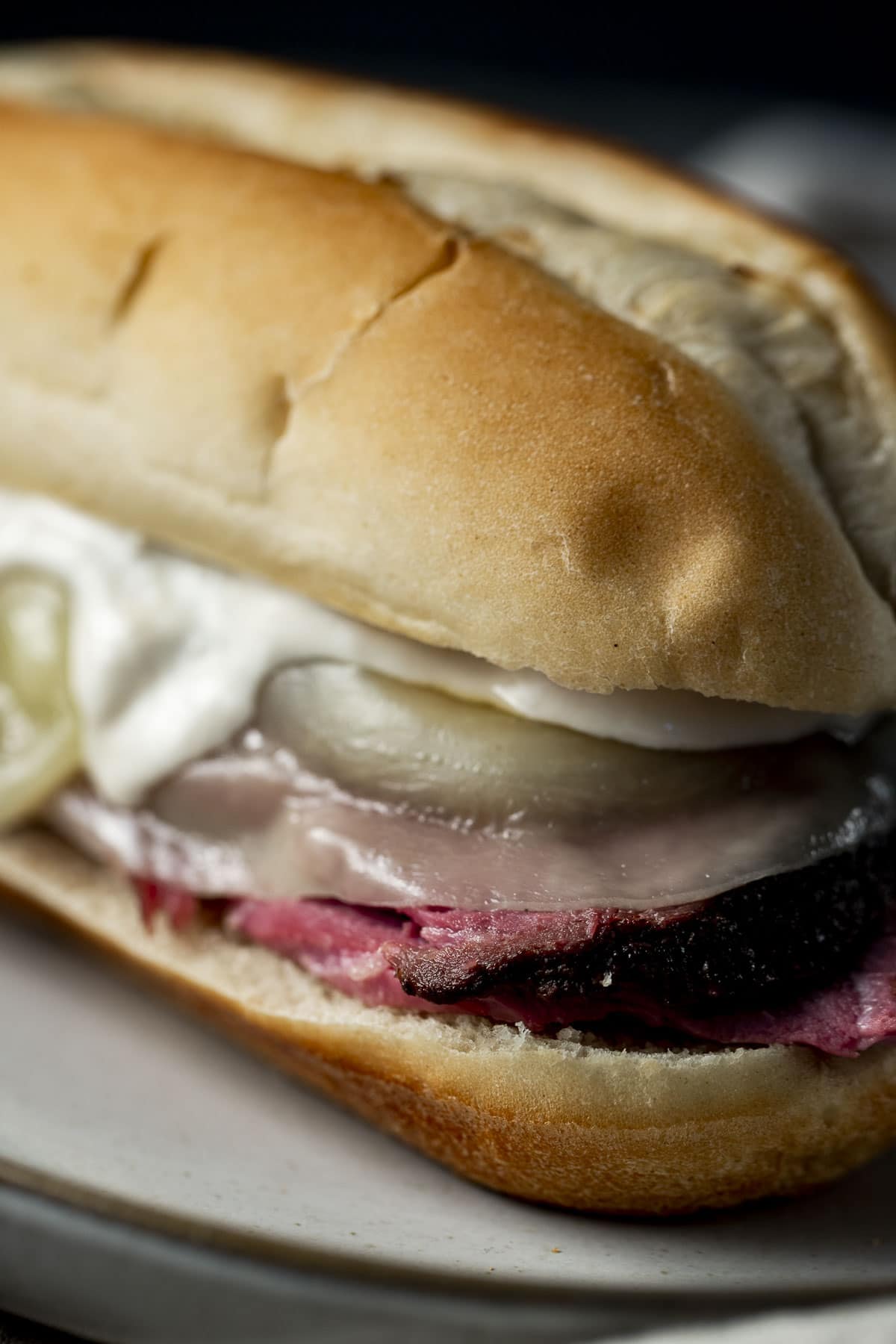
Ingredients
The full list and amounts of each ingredient can be found in the recipe card at the bottom of the post.
You’ll need a 3 pound bottom round roast for this beef dip recipe.
Round roast comes from the hind legs and rump portion of the cow. It’s a lean cut of beef that’s also referred to as rump roast. It’s inexpensive so it’s budget friendly, but it’s leaner and less tender. That’s why it’s great for low and slow cooking!
For the beef jus, you’ll need 1 ½ cups of beef stock. You can use salted, reduced sodium, no salt added or make your own beef broth.
The beef is piled on French rolls. These rolls are sturdy enough to hold up to all the toppings but soft enough to soak up the delicious beef jus. You can also use a baguette or another type of crusty bread that can handle all the toppings.
For the cheese, I love provolone with my beef dip, but Muenster or Mozzarella would also be amazing!
Lastly, I take these French dip sandwiches up a notch with a homemade horseradish sauce, which is a little spicy and tangy.
It’s not a hard sauce to make, but you’ll need a few ingredients including prepared horseradish. This is found in the condiment aisle and is made from the root of the horseradish plant.
Step by step instructions
Coat the round roast in the 2 tablespoons of salt and cracked pepper. Let it sit, uncovered, in the fridge overnight.
Heat a covered sous vide water bath to 135F degrees.
Heat a skillet over high heat until smoking. Add the round roast, fat cap side down, and sear for 1-2 minutes, until golden brown.

Flip over and sear the other side for 1-2 minutes, until a crust has formed. Continue for all sides until a brown crust is formed all around.
Remove and set aside to cool.
Turn the heat in the skillet down to medium and add the red wine. Cook down for 2-3 minutes, using a wooden spoon to scrape any bits off the bottom of the pan.
Add the peppercorns, garlic and bay leaves and continue to simmer for about 2-3 minutes.
Add the beef stock and simmer for 2-3 minutes.
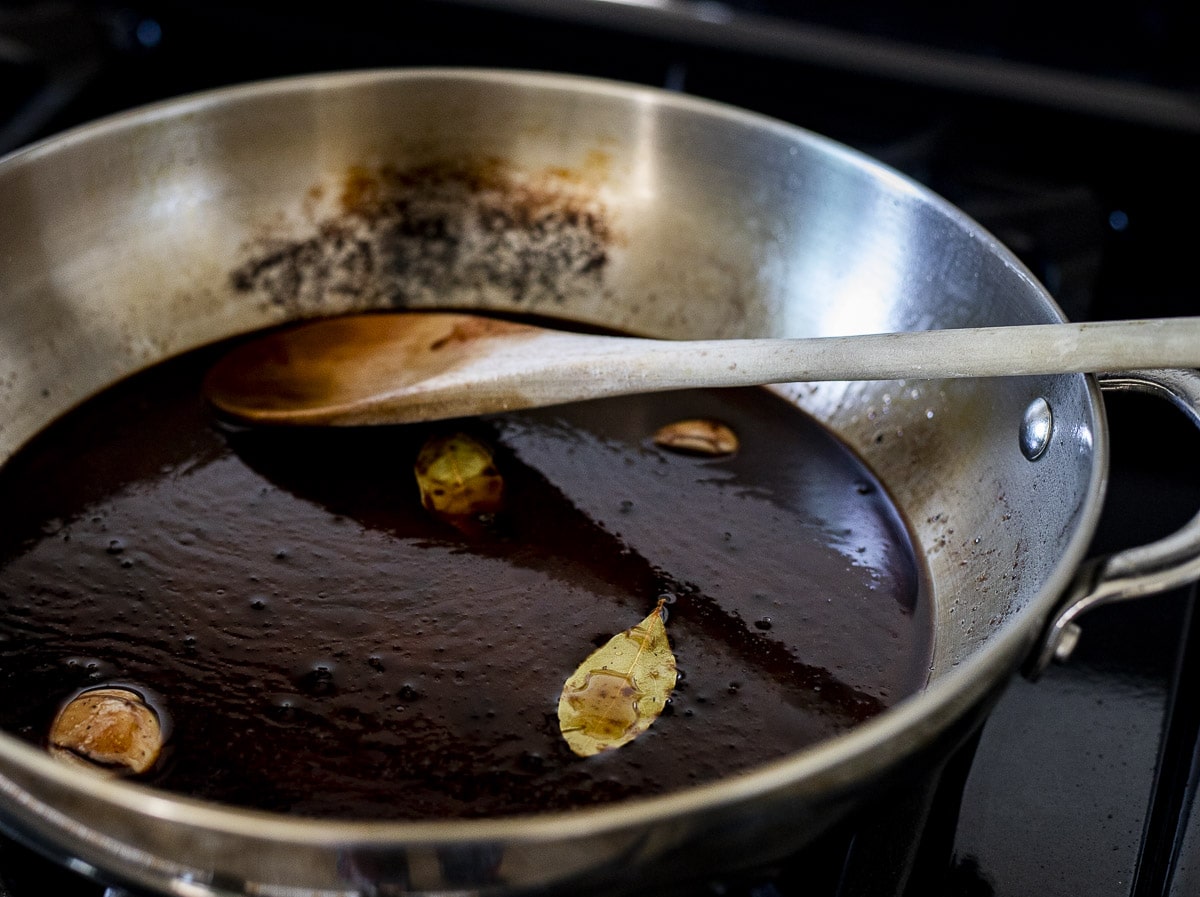
Add the additional ½ teaspoon of salt to taste if required (taste it first - if you used homemade unsalted stock, you will need to add salt here).
Turn the heat off and let the mixture cool.
Combine the beef stock mixture and the roast in a vacuum seal or ziplock bag (if using the water displacement method discussed above).
**It may be easier to use the water displacement method here as we are adding liquid to the bag.
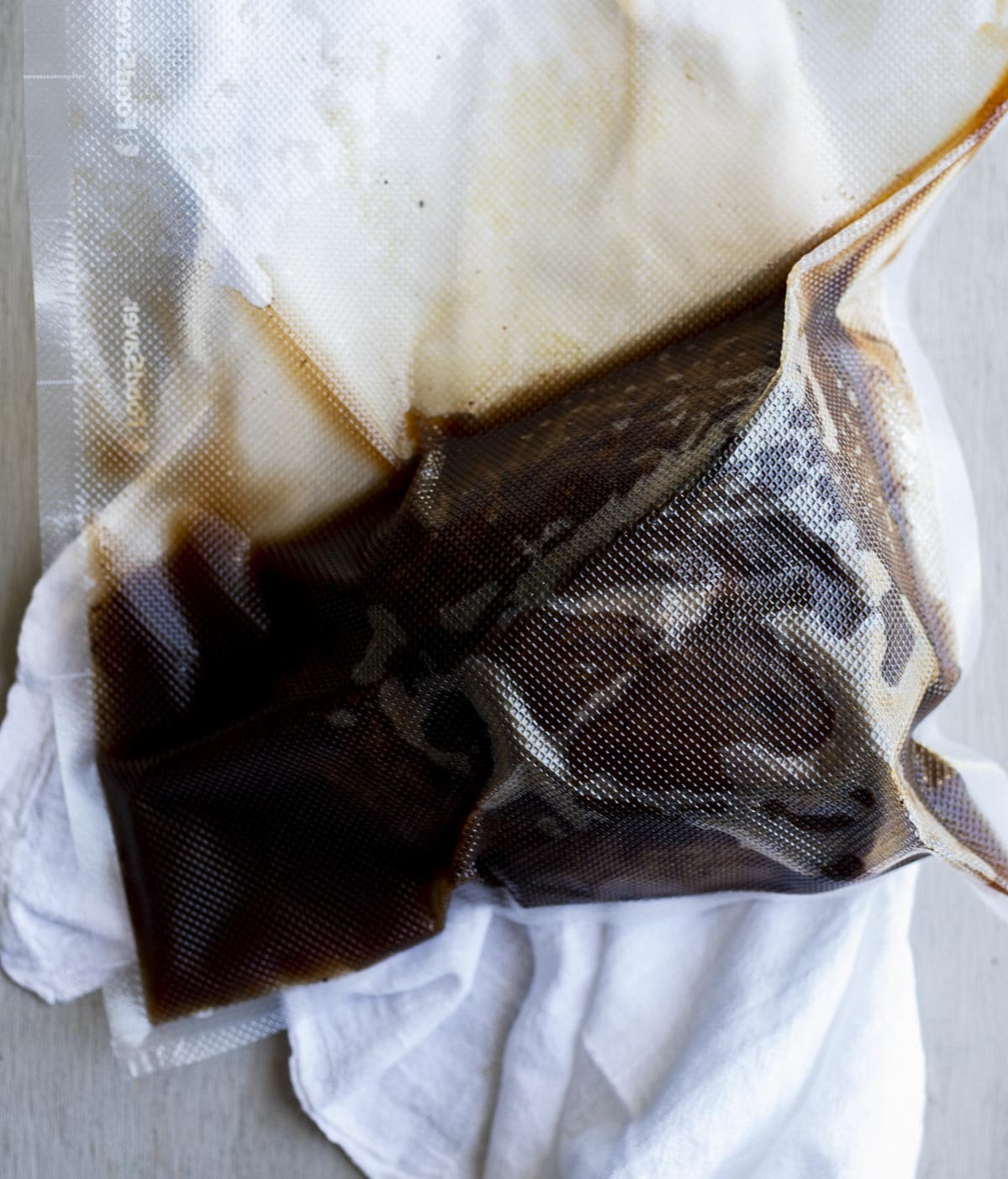
Vacuum seal the bag using the moist setting on the vacuum sealer, OR seal the top of the ziplock bag, leaving the corner open while submerging the bag so the air is pushed out. Seal once the bag is submerged.
Cook the roast for 24 hours, checking periodically to ensure too much water has not evaporated, and that your beef is remaining completely submerged.
**If the beef is floating and you're using a ziplock bag, open the corner to let the excess air out, then reseal it. If using a vacuum seal bag, you can reopen and reseal, or just weigh the bag down with something heavy like a wet towel.
During the last 10-15 minutes of the beef cooking, heat a skillet over medium heat and add the butter and onions.
Sauté for 5-7 minutes, until the onions have browned and softened. Remove and set aside.

Remove the bag from the water bath and take the meat out of the bag, reserving the jus.
Line a strainer with cheesecloth and strain the jus. If you don't have cheesecloth, you can just use a strainer, but the jus won't be as clear.
**You can strain it multiple times for extra clear jus.
Use a sharp knife to thinly slice the roast.
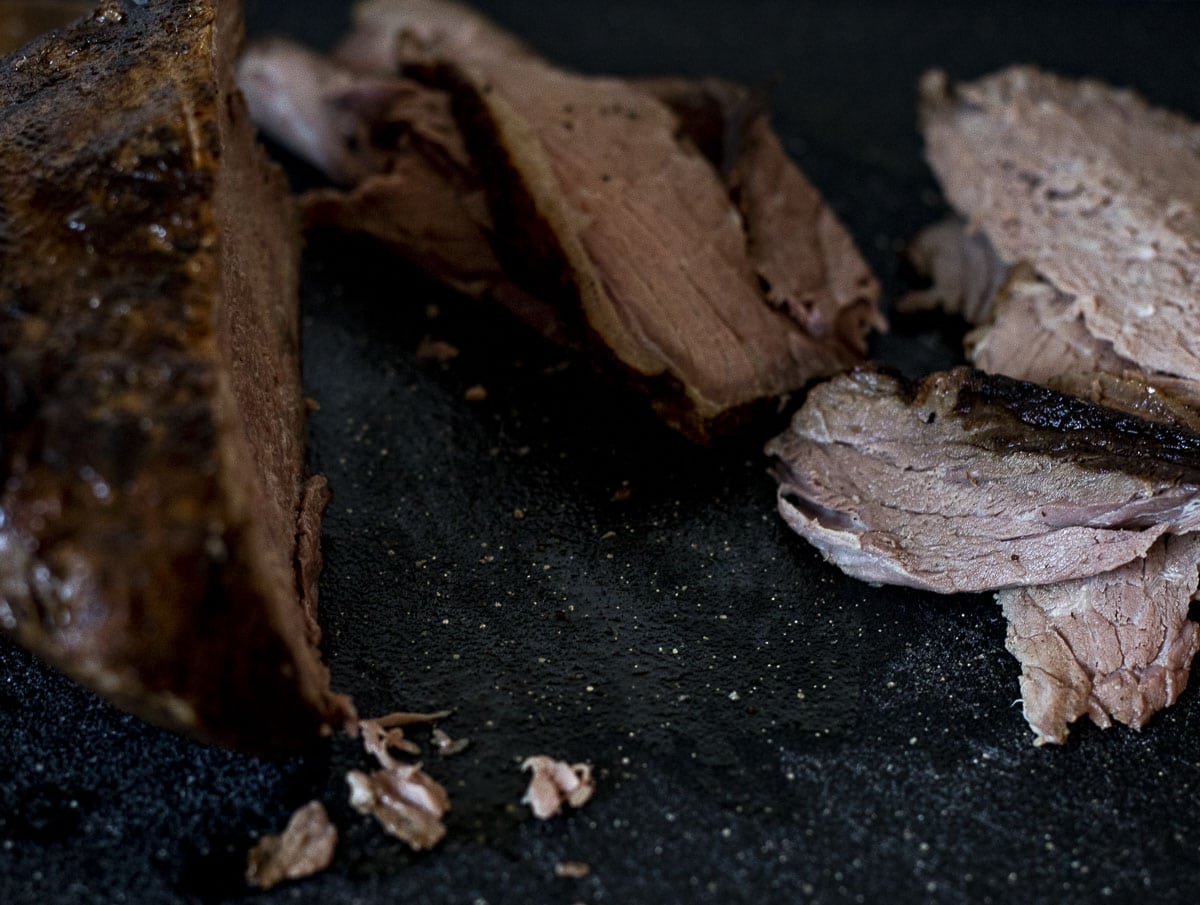
Place the beef on a French roll, add the cooked onions, top with cheese and place under the broiler for a minute or two to melt the cheese.
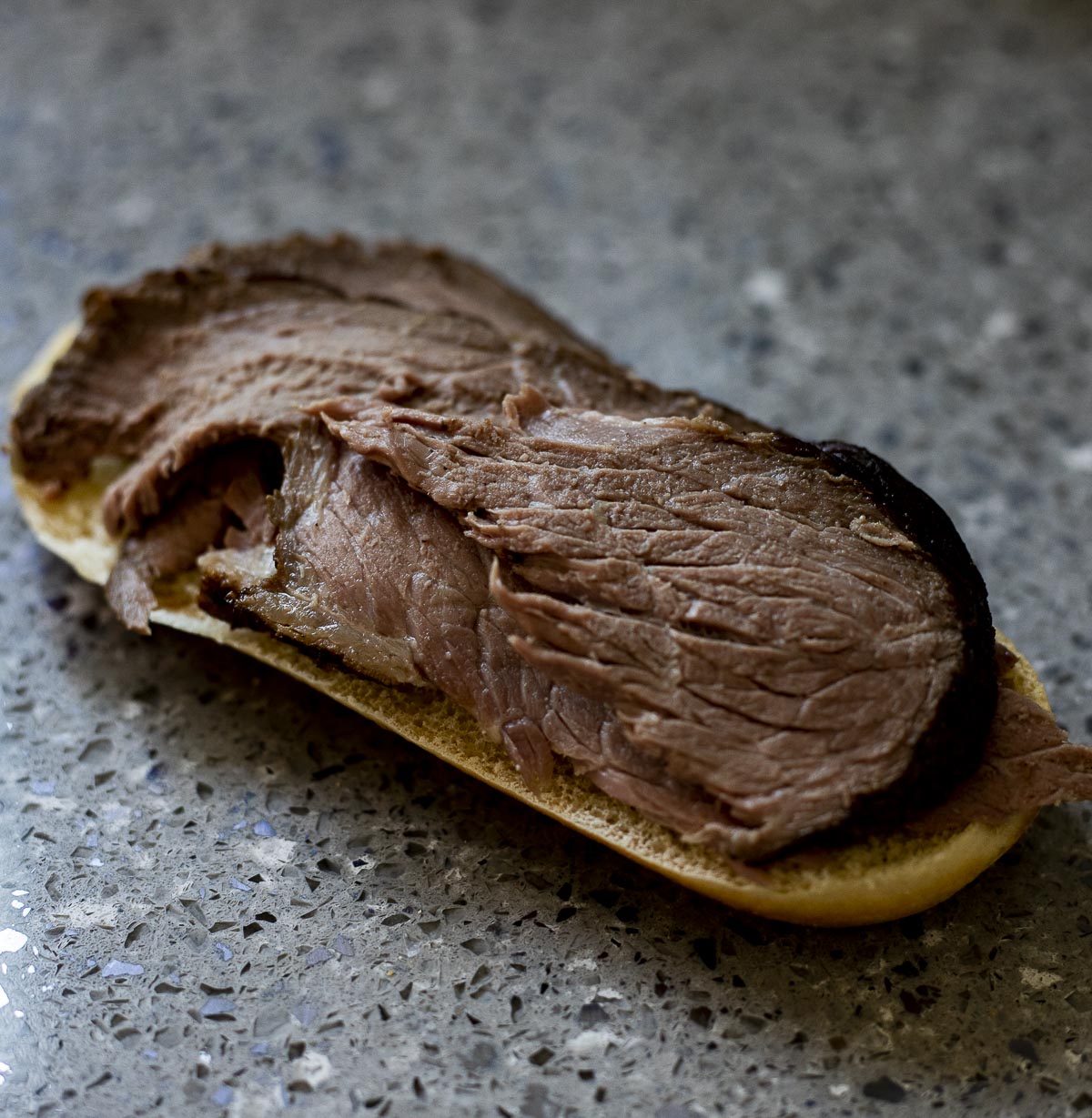
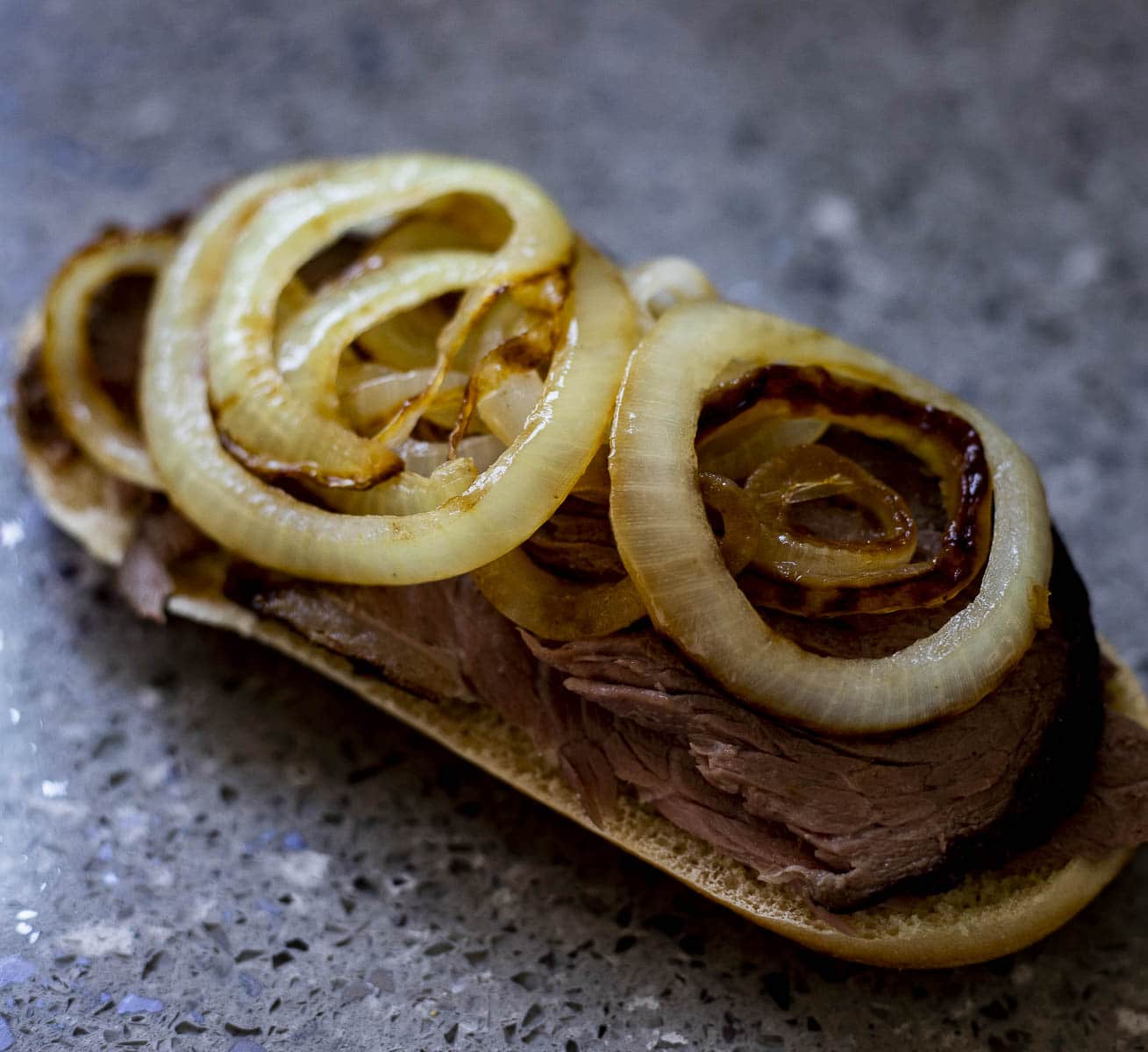
Slather it in horseradish sauce and serve with the jus on the side.
How to make the horseradish sauce
Combine all the ingredients in a bowl and mix well to combine. Add additional salt to taste, if desired.
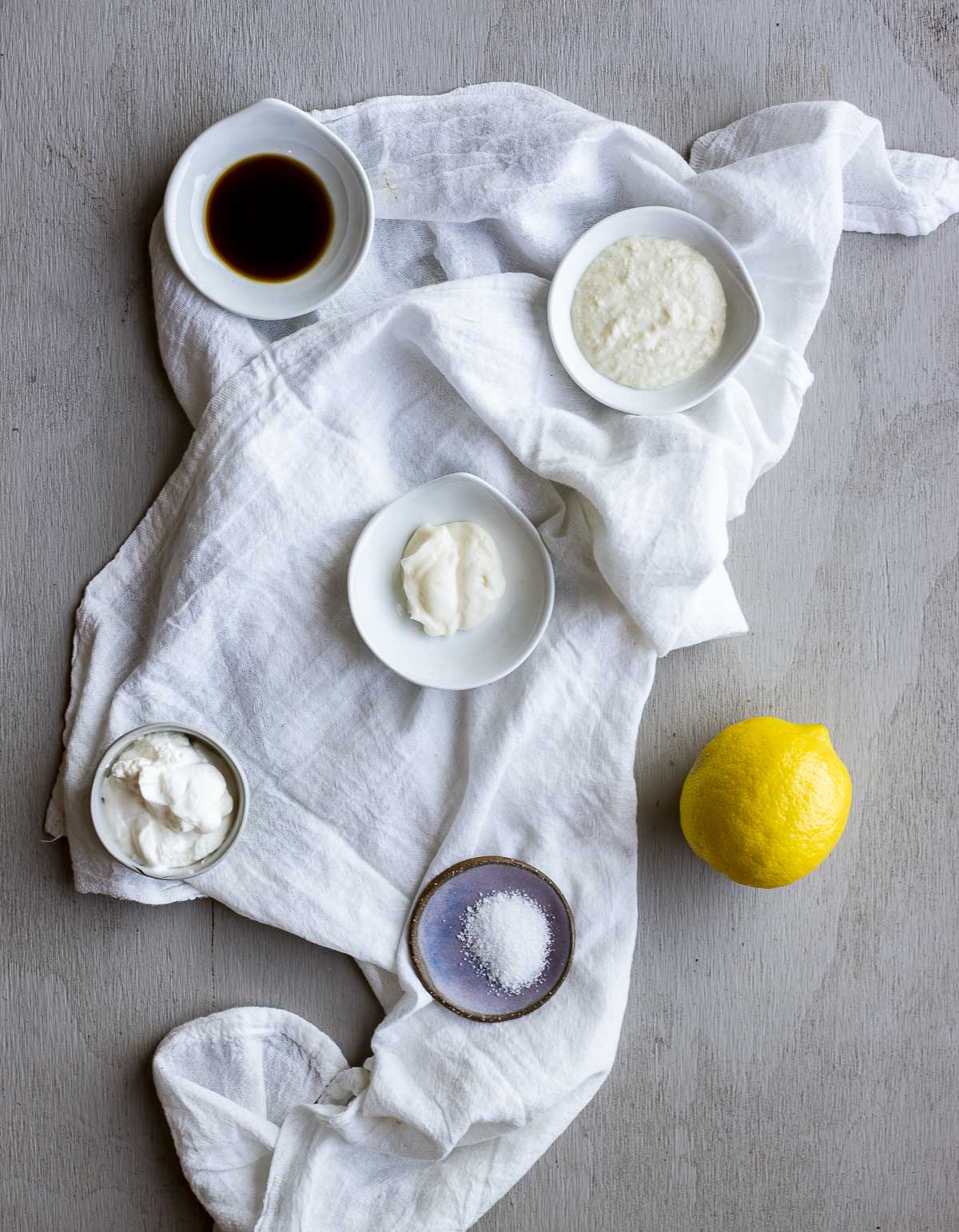

Expert tips
- Removing the air from the bag is an important step that should not be skipped to avoid bacteria entering the bag.
- For the best results, be sure to season and let the roast sit in the fridge uncovered overnight.
- It may be easier to use the water displacement method for this recipe as we are adding liquid to the bag.
- If the beef floats in the water bath and you're using a ziplock bag, open the corner to let the excess air out, then reseal it. If using a vacuum seal bag, you can reopen and reseal, or just weigh the bag down with something heavy like a wet towel.
- Make sure the water level stays high enough so the roast stays submerged in water.
- When slicing the beef for the sandwiches, make sure you use a sharp knife to cut it in thin slices.
- For the jus, you’ll want to strain it in a cheesecloth. If you don’t have cheesecloth, you can use a strainer, but you may need to strain it multiple times so it is clear.
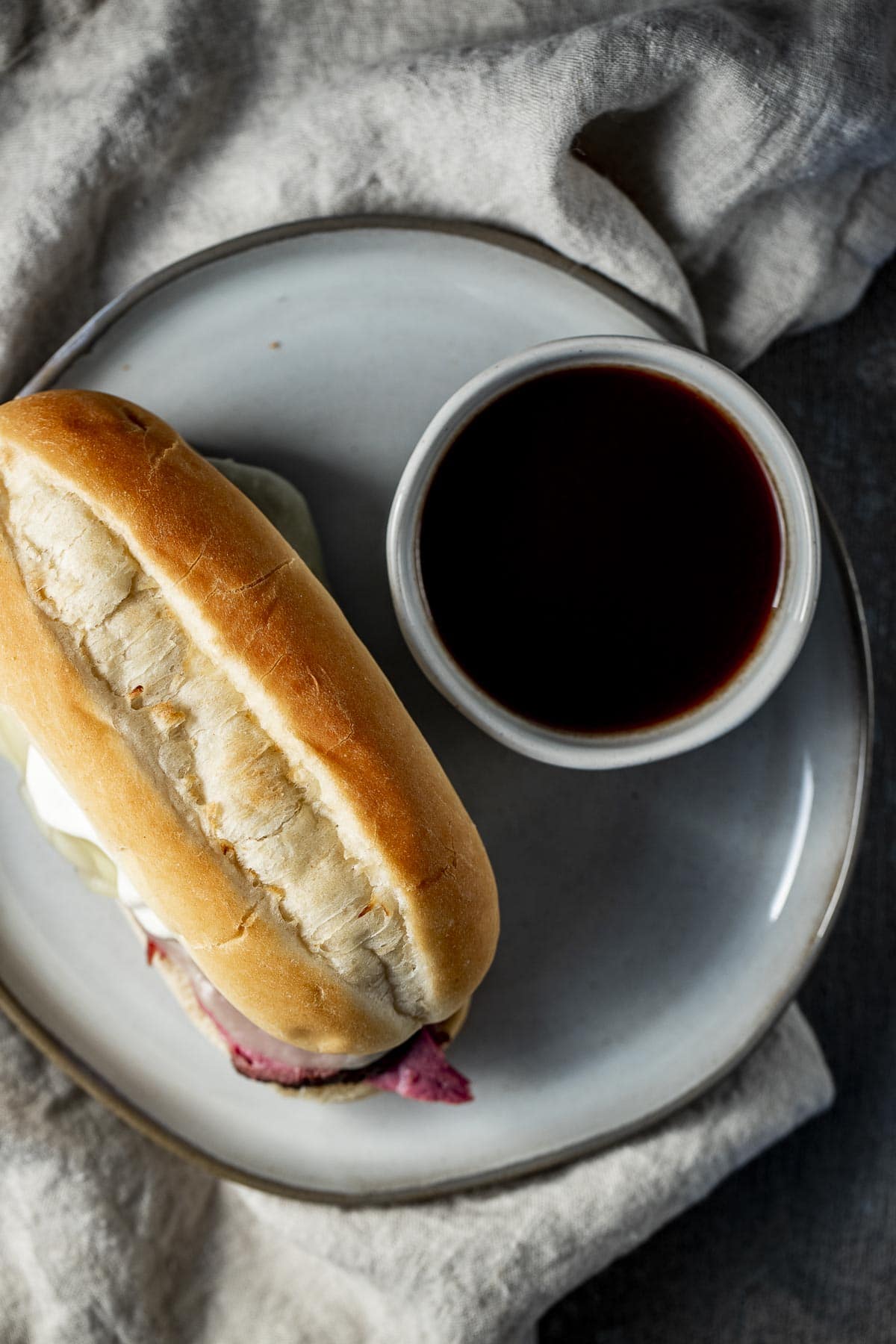
Common questions
While it isn’t absolutely necessary, letting the seasoned beef sit in the fridge overnight helps tenderize it and dries out the surface to create a better sear.
Browning the roast starts the process of locking in the juices and creates a delicious crust on the beef, which is characteristic of beef dips. It’s also essential for a flavorful jus, so I wouldn’t recommend skipping this step!
We’re cooking this roast to medium-rare, so the water bath temperature is set to 135F degrees. If you prefer your roast cooked to medium, I would suggest a water bath set to 142F degrees, and for well done you would set it to 158F degrees.
At 135F degrees, the roast will take 24 hours to cook. It will be tender but still firm enough to cut into thin slices. If you prefer your beef a little softer, you can cook it in the water bath a little longer.
Yes, you can sous vide frozen round roast for beef dip. Since we’re already cooking low and slow for 24 hours, there’s no need to add additional cooking time.
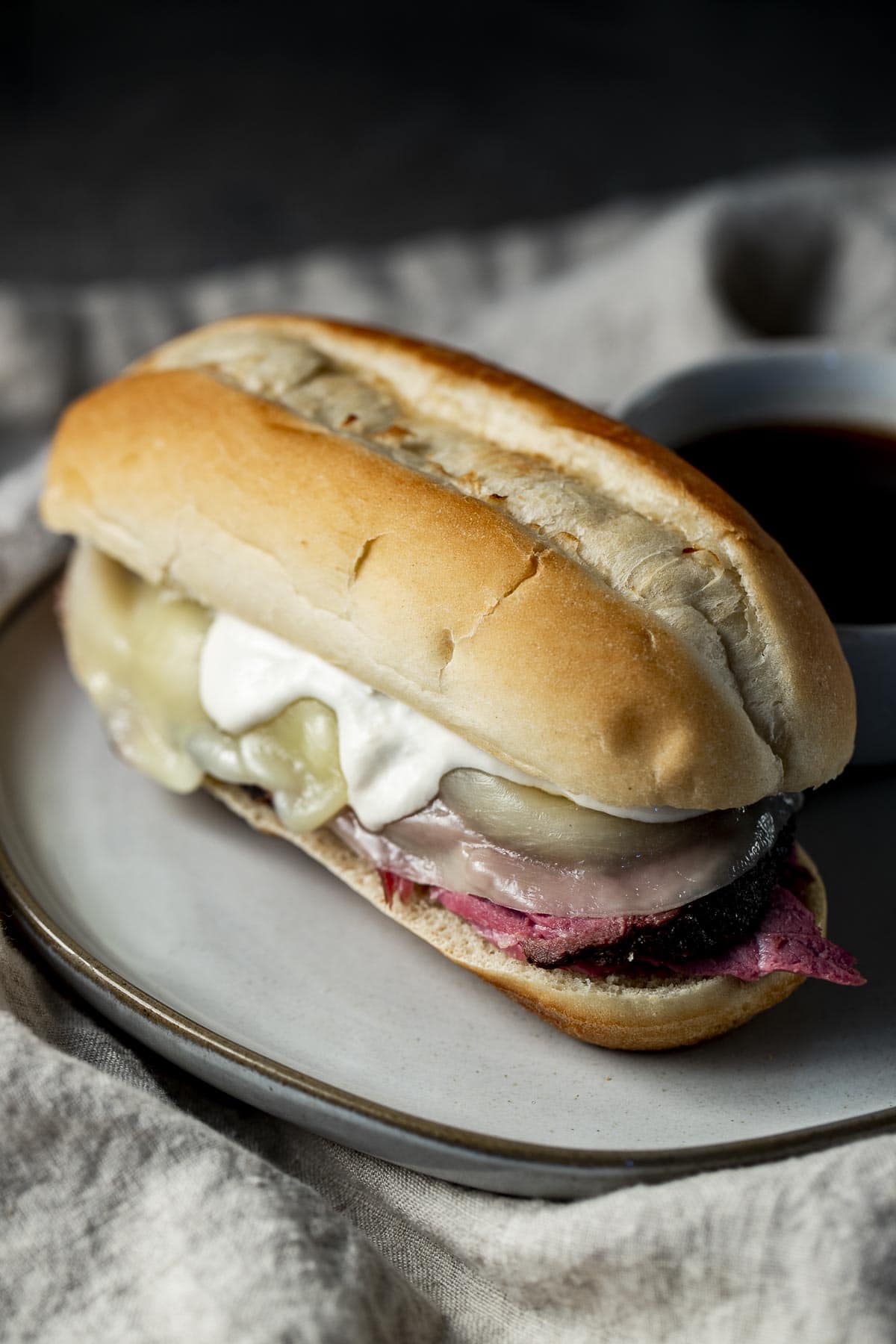
Make ahead instructions
You can cook the roast for the beef dip in advance.
Just follow the recipe up to the point of removing the roast from the water bath. Instead of opening the bag, place it in an ice bath until the beef is cooled. Store the sealed bag of beef in the fridge for up to 5 days.
To reheat the roast, place it in a 135F degree water bath for about 10-15 minutes. Then follow the rest of the recipe to make the sandwiches and horseradish sauce.
Freezing instructions
After the ice bath, transfer the vacuum sealed bag of beef to the freezer and store for up to 3 months. Thaw overnight in the fridge and then heat it in a 135F degree water bath for about 10-15 minutes and follow the rest of the recipe instructions.
If you love this recipe, please leave a star rating and a comment below and let us know your favorite thing about it. We'd also love to connect on Instagram! Follow us at @went_here_8_this for awesome recipes and all sorts of fun food stuff 🙂
Recipe
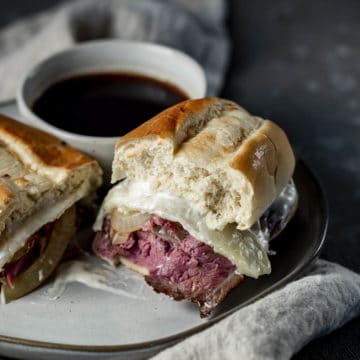
Sous Vide French Dip
Ingredients
- 3 pound bottom round roast
- 2 tablespoons salt
- 1 tablespoon cracked black pepper
- 2 garlic cloves smashed
- 2 bay leaves
- 1 ½ cups beef stock
- ½ cup red wine
- 1 tablespoon peppercorns
- ½ teaspoon salt optional
- 1 tablespoon butter
- 1 medium onion sliced
- 8-10 French rolls
- 6 ounces sliced provolone substitute Muenster or Mozarella
Horseradish sauce
- 2 tablespoons prepared horseradish
- ½ teaspoon salt
- ½ teaspoon black pepper
- ¼ cup sour cream
- 1 tablespoon mayonnaise
- 1 teaspoon Worcestershire sauce
- 1 tablespoon fresh lemon juice
Instructions
- Coat the round roast in the 2 tablespoons of salt and cracked pepper. Let it sit, uncovered, in the fridge overnight.
- Heat a covered sous vide water bath to 135F degrees.
- Heat a skillet over high heat until smoking. Add the round roast, fat cap side down, and sear for 2-4 minutes, until golden brown.
- Flip over and sear the other side for 2-4 minutes, until a crust has formed. Continue for all sides until a brown crust is formed all around.
- Remove and set aside to cool.
- Turn the heat in the skillet down to medium and add the red wine. Cook down for 2-3 minutes, using a wooden spoon to scrape any bits off the bottom of the pan.
- Add the peppercorns, garlic and bay leaves and continue to simmer for about 2-3 minutes.
- Add the beef stock and simmer for 2-3 minutes.
- Add the additional ½ teaspoon of salt to taste if required (taste it first - if you used homemade unsalted stock, you will need to add salt here).
- Turn the heat off and let the mixture cool so it won't melt the bag.
- Combine the beef stock mixture and the roast in a vacuum seal or ziplock bag (if using the water displacement method discussed above). **It may be easier to use the water displacement method here as we are adding liquid to the bag.
- Vacuum seal the bag using the moist setting on the vacuum sealer, OR seal the top of the ziplock bag, leaving the corner open while submerging the bag so the air is pushed out. Seal once the bag is submerged.
- Cook the roast for 24 hours, checking periodically to ensure too much water has not evaporated, and that your beef is remaining completely submerged.
- During the last 10-15 minutes of the beef cooking, heat a skillet over medium heat and add the butter and onions.
- Sauté for 5-7 minutes, until the onions have browned and softened. Remove and set aside.
- Remove the bag from the water bath and take the meat out of the bag, reserving the jus.
- Line a strainer with cheesecloth and strain the jus. If you don't have cheesecloth, you can just use a strainer, but the jus won't be as clear. **You can strain it multiple times for extra clear jus.
- Use a sharp knife to thinly slice the roast.
- Place the beef on a French roll, add the cooked onions, top with cheese and place under the broiler for a minute or two to melt the cheese.
- Slather it in horseradish sauce (see below) and serve with the jus on the side.
Horseradish Sauce
- Combine all the ingredients in a bowl and mix well to combine. Add additional salt to taste if desired.
Expert Tips:
- Removing the air from the bag is an important step that should not be skipped to avoid bacteria entering the bag.
- For the best results, be sure to season and let the roast sit in the fridge uncovered overnight.
- It may be easier to use the water displacement method for this recipe as we are adding liquid to the bag.
- If the beef floats in the water bath and you're using a ziplock bag, open the corner to let the excess air out, then reseal it. If using a vacuum seal bag, you can reopen and reseal, or just weigh the bag down with something heavy like a wet towel.
- Make sure the water level stays high enough so the roast stays submerged in water.
- When slicing the beef for the sandwiches, make sure you use a sharp knife to cut it in thin slices.
- For the jus, you’ll want to strain it in a cheesecloth. If you don’t have cheesecloth, you can use a strainer, but you may need to strain it multiple times so it is clear.
Nutrition
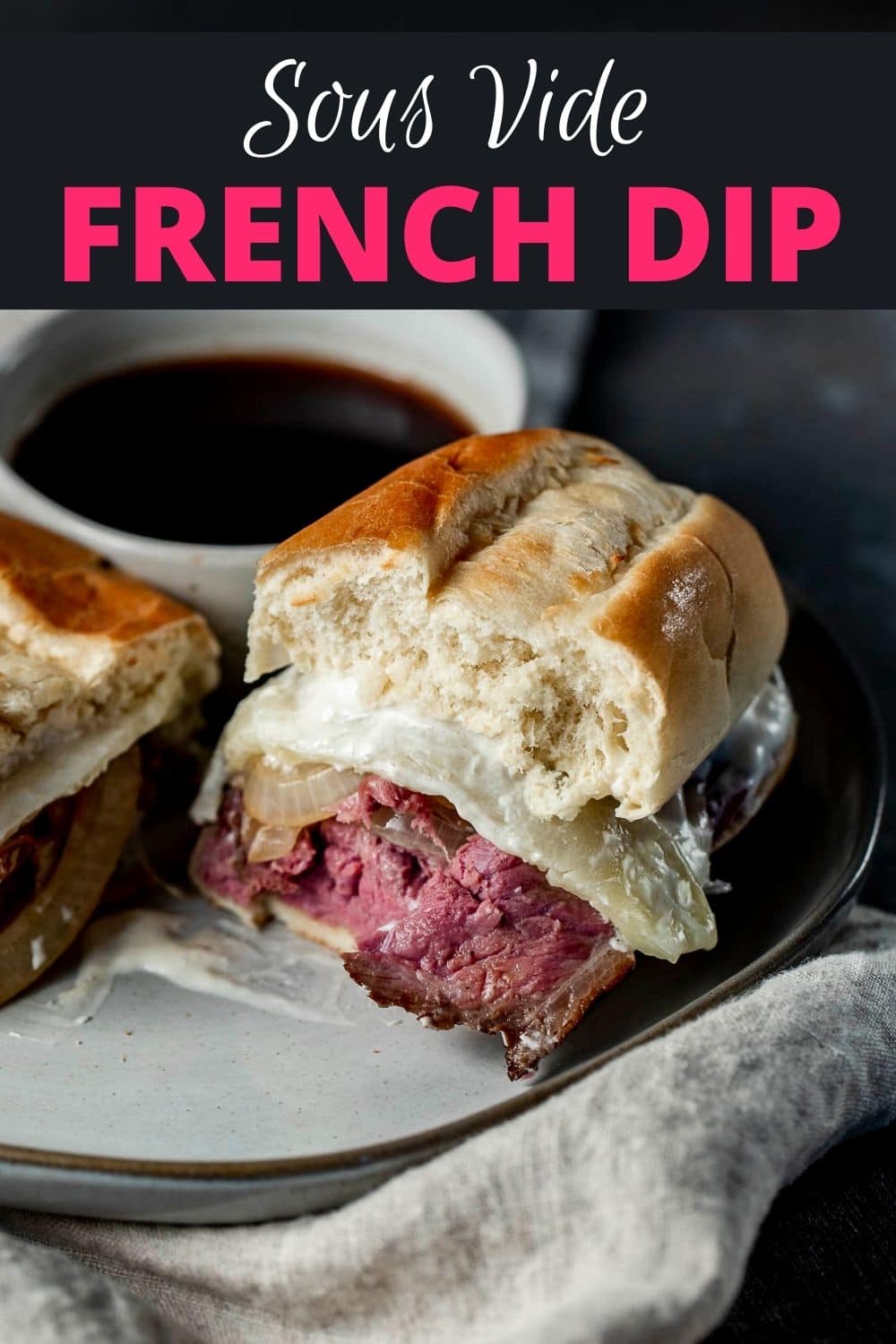




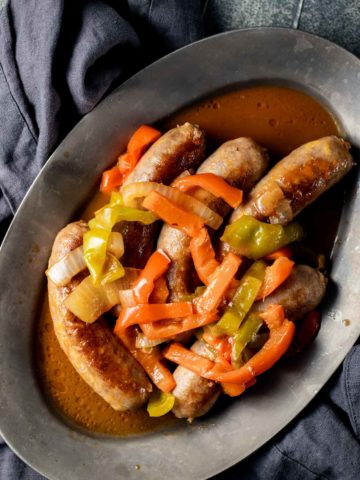
Jack says
I'm wondering, why screen the liquid? Don't the little bits add some flavor?
Danielle says
It's preference really. In traditional French dip sandwiches, it's served with a clear strained jus. You can definitely use it without straining it though!
Jane Weaver says
I have used my sous-vide to cook several different French Dip sandwiches, and this is the best by far!!
Thanks for the recipe!
Danielle says
So glad you liked it! Thanks 🙂
Megan says
What type of red wine do you recommend?
Danielle says
Any dry red wine will work. I usually use a cab or syrah, but it honestly doesn't matter too much. Anything you like!
Beth says
Oh wow! This recipe looks amazing and making my mouth water! Definitely going to try this recipe soon. Excited to have this recipe on hand!
Danielle says
Hope you get to try it Beth!
Megan Stevens says
I grew up eating French dips, and now it's so fun to have a homemade version with literally all of the components homemade; wow, well done! The melted cheese, beef and horseradish sauce are so yummy together!
Danielle says
Thanks!
Lima Ekram says
I love french dip sandwiches and this is my favorite recipe now! Every ingredient is perfect!
Danielle says
Yay - I'm so happy to hear that!
Sharmila Kingsly says
Enjoyed the whole sauce process. Nothing can beat the freshness of a homemade dip!!
Danielle says
Totally!
Ruggy says
So excited to try this. Grew up on French dip. Have it in the bag now! Only difference is we use homemade hot mustard instead of horseradish sauce. But both are great!
Danielle says
I really think you're going to love this, it was one of our favorites! Love the idea of using homemade hot mustard, I'm going to try making my own 🙂
Lauren Vavala Harris says
Ohh a French Dip sandwich sounds so good right now! This recipe is everything I remember about this tasty sandwich - can't wait to try it!
Danielle says
Hope you love it!